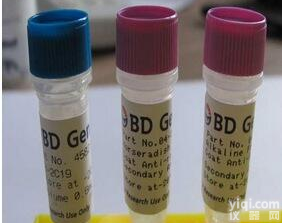| 英文名称 | Podoplanin |
| 中文名称 | 平足蛋白/淋巴管内皮细胞蛋白抗体 |
| 别 名 | Podoplanin /gp36; Podoplanin Protein; AGGRUS; GLYCOPROTEIN 36 KD; Podoplanin; Glycoprotein 36; gp 36; GP 38; GP 40; gp36; GP38; GP40; HT1A 1; HT1A1; hT1alpha1; hT1alpha2; Lung type I cell membrane associated glycoprotein; Lung type I cell membrane associated glycoprotein isoform a; Lung type I cell membrane associated glycoprotein T1A 2; OTS 8; OTS8; OTTHUMP00000009640; OTTHUMP00000044504; PA2.26; PA2.26 antigen; PDPN; Podoplanin; T1 alpha; T1 ALPHA GENE; T1A; TIA 2; TIA2. |
 | Specific References (1) | bs-1048R has been referenced in 1 publications.
[IF=1.48] Gao, Peng, et al. "Salvianolic acid B improves bone marrow-derived mesenchymal stem cell differentiation into alveolar epithelial cells type I via Wnt signaling." Molecular Medicine Reports. other ;
PubMed:25892295 |
| 规格价格 | 50ul/780元 购买 100ul/1380元 购买 200ul/2200元 购买 大包装/询价 |
| 说 明 书 | 50ul 100ul 200ul |
| 研究领域 | 肿瘤 心血管 细胞生物 免疫学 淋巴细胞 内皮细胞 |
| 抗体来源 | Rabbit |
| 克隆类型 | Polyclonal |
| 交叉反应 | Mouse, Rat, |
| 产品应用 | IHC-P=1:400-800 IHC-F=1:400-800 (石蜡切片需做抗原修复)
not yet tested in other applications.
optimal dilutions/concentrations should be determined by the end user. |
| 分 子 量 | 15kDa |
| 细胞定位 | 细胞浆 细胞膜 |
| 性 状 | Lyophilized or Liquid |
| 浓 度 | 1mg/ml |
| 免 疫 原 | KLH conjugated synthetic peptide derived from mouse Podoplanin:91-166/166 |
| 亚 型 | IgG |
| 纯化方法 | affinity purified by Protein A |
| 储 存 液 | 0.01M TBS(pH7.4) with 1% BSA, 0.03% Proclin300 and 50% Glycerol. |
| 保存条件 | Store at -20 °C for one year. Avoid repeated freeze/thaw cycles. The lyophilized antibody is stable at room temperature for at least one month and for greater than a year when kept at -20°C. When reconstituted in sterile pH 7.4 0.01M PBS or diluent of antibody the antibody is stable for at least two weeks at 2-4 °C. |
| PubMed | PubMed |
| 产品介绍 | background:
This gene encodes a type-I integral membrane glycoprotein with diverse distribution in human tissues. The physiological function of this protein may be related to its mucin-type character. The homologous protein in other species has been described as a differentiation antigen and influenza-virus receptor. The specific function of this protein has not been determined but it has been proposed as a marker of lung injury. Alternatively spliced transcript variants encoding different isoforms have been identified. [provided by RefSeq, Jul 2008]
Function:
May be involved in cell migration and/or actin cytoskeleton organization. When expressed in keratinocytes, induces changes in cell morphology with transfected cells showing an elongated shape, numerous membrane protrusions, major reorganization of the actin cytoskeleton, increased motility and decreased cell adhesion. Required for normal lung cell proliferation and alveolus formation at birth. Induces platelet aggregation. Does not have any effect on folic acid or amino acid transport. Does not function as a water channel or as a regulator of aquaporin-type water channels.
Subcellular Location:
Membrane; Single-pass type I membrane protein. Cell projection, filopodium membrane; Single-pass type I membrane protein. Cell projection, lamellipodium membrane; Single-pass type I membrane protein. Cell projection, microvillus membrane; Single-pass type I membrane protein. Cell projection, ruffle membrane; Single-pass type I membrane protein. Note=Localized to actin-rich microvilli and plasma membrane projections such as filopodia, lamellipodia and ruffles.
Tissue Specificity:
Highly expressed in placenta, lung, skeletal muscle and brain. Weakly expressed in brain, kidney and liver. In placenta, expressed on the apical plasma membrane of endothelium. In lung, expressed in alveolar epithelium. Up-regulated in colorectal tumors and expressed in 25% of early oral squamous cell carcinomas.
Post-translational modifications:
Extensively O-glycosylated. Contains sialic acid residues. O-glycosylation is necessary for platelet aggregation activity.
The N-terminus is blocked.
Similarity:
Belongs to the podoplanin family.
SWISS:
Q62011
Gene ID:
14726
Database links: Entrez Gene: 10630 Human Entrez Gene: 14726 Mouse Entrez Gene: 54320 Rat Omim: 608863 Human SwissProt: Q86YL7 Human SwissProt: Q62011 Mouse SwissProt: Q64294 Rat Unigene: 468675 Human Unigene: 2976 Mouse Unigene: 794 Rat
Important Note:
This product as supplied is intended for research use only, not for use in human, therapeutic or diagnostic applications.
Podoplanin Protein是一种肾小球足状突细胞膜粘蛋白,目前已成为一种新的淋巴管内皮标记物蛋白,在少数小静脉上也有表达。
podoplanin Protein是淋巴管内皮高度敏感且特异性的标记物,作为肿瘤细胞的血小板聚集介导因子而发挥作用,能促进肿瘤细胞迁移及增加肿瘤细胞侵袭力。 |
| 产品图片 | 
Paraformaldehyde-fixed, paraffin embedded (rat brain tissue); Antigen retrieval by boiling in sodium citrate buffer (pH6.0) for 15min; Block endogenous peroxidase by 3% hydrogen peroxide for 20 minutes; Blocking buffer (normal goat serum) at 37°C for 30min; Antibody incubation with (Podoplanin) Polyclonal Antibody, Unconjugated (bs-1048R) at 1:400 overnight at 4°C, followed by a conjugated secondary (sp-0023) for 20 minutes and DAB staining.

Tissue/cell: mouse kidney tissue; 4% Paraformaldehyde-fixed and paraffin-embedded;
Antigen retrieval: citrate buffer ( 0.01M, pH 6.0 ), Boiling bathing for 15min; Block endogenous peroxidase by 3% Hydrogen peroxide for 30min; Blocking buffer (normal goat serum,C-0005) at 37℃ for 20 min;
Incubation: Anti-Podoplanin Protein/gp36 Polyclonal Antibody, Unconjugated(bs-1048R) 1:200, overnight at 4°C, followed by conjugation to the secondary antibody(SP-0023) and DAB(C-0010) staining |
 Podoplanin 平足蛋白/淋巴管内皮细胞蛋白抗体
Podoplanin 平足蛋白/淋巴管内皮细胞蛋白抗体
 Podoplanin平足蛋白/淋巴管内皮细胞蛋白抗体
Podoplanin平足蛋白/淋巴管内皮细胞蛋白抗体
 hy034734 平足蛋白gp36,淋巴管内皮细胞蛋白抗体,TIA2
hy034734 平足蛋白gp36,淋巴管内皮细胞蛋白抗体,TIA2
 Podo平足蛋白gp36/淋巴管内皮细胞蛋白抗体
Podo平足蛋白gp36/淋巴管内皮细胞蛋白抗体
 Anti-Podoplanin Protein抗体,平足蛋白gp36/淋巴管内皮细胞蛋白抗体价格
Anti-Podoplanin Protein抗体,平足蛋白gp36/淋巴管内皮细胞蛋白抗体价格
 Anti-Podoplanin Protein抗体,平足蛋白gp36/淋巴管内皮细胞蛋白抗体价格
Anti-Podoplanin Protein抗体,平足蛋白gp36/淋巴管内皮细胞蛋白抗体价格
 Biotin 标记Podoplanin Protein抗体,平足蛋白gp36/淋巴管内皮细胞蛋白抗体
Biotin 标记Podoplanin Protein抗体,平足蛋白gp36/淋巴管内皮细胞蛋白抗体
 Podoplanin Protein抗体,平足蛋白gp36/淋巴管内皮细胞蛋白抗体
Podoplanin Protein抗体,平足蛋白gp36/淋巴管内皮细胞蛋白抗体
 Podoplanin Protein抗体,平足蛋白gp36/淋巴管内皮细胞蛋白抗体FITC.PE
Podoplanin Protein抗体,平足蛋白gp36/淋巴管内皮细胞蛋白抗体FITC.PE
 平足蛋白gp36/淋巴管内皮细胞蛋白抗体
平足蛋白gp36/淋巴管内皮细胞蛋白抗体
 平足蛋白gp36/淋巴管内皮细胞蛋白抗体
平足蛋白gp36/淋巴管内皮细胞蛋白抗体
 平足蛋白gp36/淋巴管内皮细胞蛋白免疫组化试剂盒
平足蛋白gp36/淋巴管内皮细胞蛋白免疫组化试剂盒